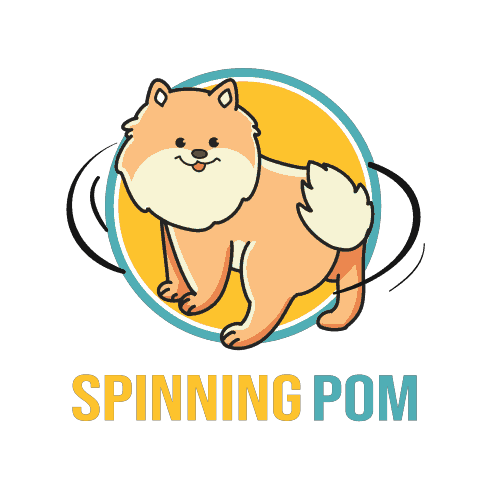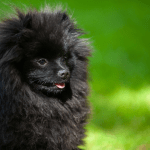Pomeranians are at risk of various skin allergies that can easily be treated and often are not threatening to their skin or coat in the long term. However, Black Skin Disease, also known as Alopecia X, is a Pomeranian health problem that can carry long term effects on your Pomeranian.
Defining Black Skin Disease
So what is Black Skin Disease? Simply put, it’s a disease of the skin that results in permanent hair loss and grey to black colored skin. These are detrimental outcomes that are difficult to reverse and have numerous other side effects, including being susceptible to other skin related issues, being easily cold, and being exposed to the world’s elements.
Unfortunately, Black Skin Disease is little understood in the medical world. The technical term for it is Alopecia X due to the causes of the condition being relatively unknown. On top of that, treatments tend to be trial and error with some professionals believing the known treatment results to be random in nature. Other names for this disease include Adult Onset Growth Hormone Deficiency, Growth Hormone-Responsive Alopecia, Castration-Responsive Alopecia, and, more recently, Adrenal Hyperplasia-Like Syndrome.
No one wants their Pomeranians to live through this condition. Unfortunately, it’s quite common among Nordic and smaller dogs including Siberian Huskies, Alaskan Malamutes, Chow Chows, Samoyeds, and Toy Poodles. When it comes to Pomeranians, this could be due to their ancestral relationship with Arctic working dogs.
When a Pomeranian is diagnosed with Black Skin Disease, the most common outcome is that they go completely bald, either in patches or throughout the body. The early onset symptoms can occur up to one year old, but it’s been seen in Pomeranians up to ten years old. There are no symptoms of Black Skin Disease other than hair loss and a change of color in the skin. This is why it’s very important to notify your veterinarian if you start to notice these symptoms at all.
While it can be traumatizing to see the beautiful hair of your Pomeranian disappear to an unfair disease, it’s not life-threatening in the least. Black Skin Disease is purely a cosmetic issue that only affects the appearance of your Pomeranian. However, it doesn’t have to be life-threatening for it to be traumatizing and sad. I’ve been fortunate enough that none of my Pomeranians have had any of these symptoms and I pray never to see them.
The main issue with the loss of hair on a Pomeranian is that they lose both their guard coat and base coat. The thing with Pomeranians is that they have two coats of hair thanks to their Arctic ancestors. The purpose of the guard coat is to easily brush things off and keep the base coat relatively safe. The purpose of the base coat is to keep Pomeranians warm in colder climates.
The problem with your Pomeranian losing their base coat is that they can never grow it back. This is why groomers who cut the hair of Pomeranians should always be very careful when giving our joys their haircuts. It’s also a very good reason why Pomeranian parents like ourselves should be very cautious when presenting a fashion statement with our Pomeranian’s hair.
If your Pomeranian isn’t able to grow their hair back, it’s a huge loss for them and can even change their attitude. The double coated Pomeranian, with their big beautiful hair, is one of the most emblematic characteristics of a Pomeranian. Take that away and you take away some of their character.
I believe the issue of Black Skin Disease is quite clear now and we should know when to spot the signs if it becomes an issue. It’s very important that we pay attention to these symptoms. However, it’s also important to know the causes of this problem so we can better understand how to approach preventing and treating it.
Causes of Black Skin Disease
Knowing the cause of any issue is important so that we can better understand the source of the problem. As I mentioned before, the causes of Black Skin Disease are quite limited as this particular field of study is rather new in the veterinary world.
With that in mind, there are a few theories out there regarding the causes of Alopecia X and thus Black Skin Disease.
As is the case for the other Pomeranian health problems, the main causes of Black Skin Disease have been determined to be rooted in their genetic history. This means that since it’s genetic, it’s very hard to combat it. These types of causes are, again, rooted in the genetic ancestry of our Pomeranians due to the type of breeding done to produce what we know today as the Pomeranian.
There is a theory that one of the causes could be due to an altered sex hormone metabolism, which has a direct link to canine hair growth and Alopecia X at a molecular level. Currently, this is the closest researchers have gotten to determine the true cause of Black Skin Disease in Pomeranians.
Altered sex hormone metabolism is essentially the estrogen and testosterone of female and male Pomeranians, respectively, not being metabolized, or processed, properly. Actually, estrogen helps regulate hair follicle biology by inhibiting this process. When these hormones are imbalanced, then there is possibly an oncoming condition will happen in a Pomeranian or another dog. Now, this is not always resulting in Black Skin Disease, but apparently there are notable connections between the cause and effect.
It’s also been suggested that factors such as obesity and allergies are contributors to Black Skin Disease. Some believe that there is some inherited defect in the normal hair growth cycle as well as an inherited unstable hormone metabolism, similar to what we just discussed. It’s also very possible that Black Skin Disease isn’t just one disease at all but instead a mix of several, resulting in proper diagnosis and treatment far more difficult.
Again, this is a very new clinical territory that needs further exploration by today’s doctors and scientists. At this point, we can only wait and see when a true cause is discovered, which should shed light into effective preventions and treatments for our Pomeranians.
How to Prevent Black Skin Disease
Preventing Black Skin Disease, as you can imagine at this point, is not an easy task. With truly unknown causes and such mystery around the disease, there are really only theories and general guidelines of keeping your Pomeranian’s hair and skin healthy.
One clear way of attempting to avoid Black Skin Disease in your Pomeranian is to make sure that their hair is as healthy as can be. We all want our Pomeranians to look good and feel good, and having puffy and pretty hair is a good way to achieve that. However, it’s also important for your Pomeranian’s health.
Be sure to wash your Pomeranian whenever their smell starts to turn south. You know what I’m talking about. The smell cannot be ignored. Nowadays it’s easy to find high-quality shampoo and leave-in conditioners that are safe and effective even when used relatively frequently.
Personally, I wash my Pomeranians every two weeks regardless of their smell because I want to make sure their coat and skin are the healthiest they can be.
Also, it’s possible that giving them a daily spray of a coat and skin formula after their daily brush is helpful. These sprays proactively fight all kinds of fungus and bacteria, they help ease symptoms of ringworm, and contain natural ingredients including aloe vera, oatmeal, essential fatty acids, vitamin E, and vitamin D. They even help moisturize, soothe, and clean their skin and coat to keep your Pomeranians cuddly!
These are really just general hygienic preventions that I believe every Pomeranian parent should be following. However, there are some other theories related to the potential causes laid out in the previous section that could also prove to be useful.
Since one of the main theories behind the cause of Black Skin Disease in Pomeranians is a hormone imbalance, veterinarians commonly suggest to spay or neuter your Pomeranian to remove the issue of a hormone imbalance all together. All of my Pomeranians had been spayed or neutered before being aware of the potential causes of Black Skin Disease, but it’s helpful to know nonetheless.
As one of the potential causes of this terrible disease is in fact obesity, it’s clear that feeding your Pomeranian with healthy food from trusted brands is a must. As Pomeranian parents should be doing this anyway, but it’s simply an added benefit if it means avoiding Black Skin Disease. Keep in mind that your Pomeranian doesn’t need to go on a diet. However, certain human food should be avoided in general. I know it’s hard sometimes to not give them any!
It’s also been suggested that a possible effective prevention method is to reduce the amount of stress in your Pomeranian’s environment. Funny enough, removing stressful situations from people also produces added benefits that were previously unknown, so it’s fully possible that this sort of change could change your Pomeranian’s life for the better in more ways than one.
Even though Black Skin Disease is still a bit of a mystery in the veterinary world, it’s important to know what’s out there, potential causes, and how to potentially prevent this terrible disease. I like to think that if I take care of my Pomeranians’ over health and wellness in terms of hygiene, happiness, and appearance, it can really make a difference in their lives.
But is Black Skin Disease treatable? With all of this mystery surrounding this condition, it almost seems like there’s no hope at all. Well, surprisingly enough there are actually several ways to treat Black Skin Disease which we’ll get into next.
Best Ways to Treat Black Skin Disease
We’ve learned that Black Skin Disease is by far one of the most unfair and difficult Pomeranian health problems to overcome. But there are ways in which we can go about treating our Pomeranians so that they can hopefully live a happy life full of joy and puffiness.
As we discussed, Black Skin Disease is a form of baldness and skin color changing. While it’s purely a cosmetic condition, it’s incredibly unpleasant to see our Pomeranians go through something like this. Treatments for Black Skin Disease are at best a trial and error approach since the underlying cause of it is not fully known. With that in mind, the overall goal is to restore your Pomeranian’s coat and, hopefully, prevent hair loss from happening again.
Most hormone-based hair losses are very similar. Before treating your Pomeranian with Black Skin Disease, your veterinarian will attempt to rule out any disease that might appear similar to Black Skin Disease. These similar diseases could be Cushing’s disease and hypothyroidism.
If in fact Black Skin Disease is caused by hormonal imbalances, then hormone therapies for your Pomeranian can be very helpful. The first step in treating Black Skin Disease under these conditions is to spay or neuter your Pomeranian. There are many health and behavioral benefits to spaying or neutering your Pomeranian in addition to helping manage the symptoms of Black Skin Disease.
Fortunately, many Pomeranians will re-grow most if not all of their coat after they are spayed or neutered because of the hormonal changes that occur following these procedures. Sadly, hair re-growth is not always permanent
If your Pomeranian has been spayed or neutered and some months go by without their coat coming back, your vet could possibly suggest performing oral melatonin therapy. Melatonin is a supplement that can be purchased over-the-counter and used for two to three months as needed. Over 50% of dogs that go through this therapy show hair growth in about six to eight weeks, which can be very exciting for you and your Pomeranian. I personally suggest K9 Select Melatonin for Dogs (link to read reviews on Amazon).
The moment hair growth appears to be stable, the amount of melatonin given to your Pomeranian should be gradually reduced. Over time, your vet may suggest that your Pomeranian stop the treatment. Unfortunately, there’s no guarantee that hair loss won’t continue. You should speak to your veterinarian on the dosage size because it isn’t an FDA approved supplement and it has the effect of producing drowsiness and sedation. It also has an effect on Pomeranians with diabetes, so more reason to speak thoroughly with your veterinarian.
Another form of hormone therapy that could be effective is Methyltestosterone therapy. Your veterinarian will most likely only resort to this if the melatonin therapy had no effect because periodic blood work on your Pomeranian is required. The reason for the blood work is due to the fact that this therapy can be toxic to the liver. Another side effect is that it’s likely to increase aggression in your Pomeranian. As you can probably tell, this is a potential heavy-hitter therapy that must be seriously considered before resorting to it.
There’s another possible treatment called Lysodren, which is often used to treat Pomeranians with Cushing’s disease. What Lysodren does is it limits the number of specific hormones made and passed around the body, which directly affects the same glands that produce your Pomeranian’s sex hormones. Even though your Pomeranian may not have Cushing’s disease, this indirect attack on Black Skin Disease has shown to provide useful results. Similar to Methyltestosterone therapy, your veterinarian will have to perform regular blood tests to keep track of your Pomeranian’s hormone levels.
An alternative option to the previous therapies is through the use of growth hormones since this can alter the deficiency of your Pomeranian’s sex hormones. The problem with growth hormones is that they’re genetically engineered products, which means they’re not easy to purchase even as a prescription. If you end up resorting to the use of growth hormones, you’ll need to find a veterinarian who not only can provide these hormones but can properly administer them for your Pomeranian.
There’s no doubt that your Pomeranian deserves to live the best life with good health and lots of happiness. When Pomeranians have Black Skin Disease, it can be very traumatizing and difficult to cope with, so considering the proper course of treatment is important. Be sure to communicate as much as you can to an experienced veterinarian if you start noticing symptoms of this disease.





